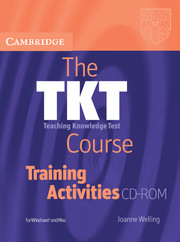3.7 - Correction strategies
Published online by Cambridge University Press: 09 February 2024
Summary
Instructions
1. Elicit different possible teachers’ responses when learners make a mistake in speaking. Write them on the board and include the following:
• Peer correction
• Echo correction (with rising intonation)
• Finger correction
• Identifying the mistake through explanation
• Ignoring the error (focusing on content and communication)
• Focusing on minimal pair work
• Seeking to clarify ideas
• Gesture
• Delaying feedback
• Feeding in the correct language
2. Explain that around the room are various examples of learners’ oral errors, each with three possible correction strategies. Show trainees the answer grid and explain that for each example they should 1) identify the error 2) summarise the possible strategies and 3) choose the ‘best’ strategy and say why they chose it.
3. Hand out the answer grid and have trainees work in pairs or threes. Monitor, promoting discussion and clarifying where necessary.
4. Conduct feedback using the answer key below, but stress that there are pros and cons of each method. Draw out the following factors which affect decisions about correction and write them on the board:
• student's level
• error or slip – can the student self-correct?
• activity taking place
• stage of lesson/learning
• self-confidence of student
• motivation of student
• frequency of mistake
• who's listening
• reason for speaking
Work towards the conclusion that different strategies are more or less appropriate in different situations, but that certain kinds of mistakes lend themselves to certain correction techniques.
- Type
- Chapter
- Information
- The TKT Course Training Activities , pp. 81 - 83Publisher: Cambridge University PressFirst published in: 2024

